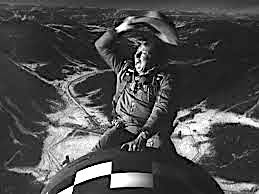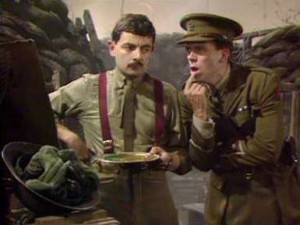To avoid comic archetypes becoming stereotypes or clichés, place them in a fresh identity and setting of your own devising.
Stanley Kubrik’s Dr Strangelove or: How I Learned to Stop Worrying and Love the Bomb is widely regarded as a breakthrough in cinema satire. The story concerns the US President’s attempts to save the world from nuclear obliteration when an insane US Air Force general orders a nuclear strike on the Soviet Union. The film features archetypal characters in incongruous guises.
The runaway B52 bomber commander, Major T.J. ‘King’ Kong, is written and played as an archetypal cowboy. Clad in a cowboy hat and boots, he speaks with a strong Southern accent and yells ‘Yee-ha!’ as he rides a falling hydrogen bomb as if it’s a rodeo bull. Doctor Strangelove himself is depicted as a classic Mad Scientist archetype. The signs of his madness manifest in his ludicrous plans for humanity’s future and his failure to control his Hitler-saluting right arm.
The US President seems more suited to a primary school staff room than the heart of American military power. His conversations with the Russian leader have the hallmarks of a petty squabble between an indulgent teacher and a child – “[Major Kong] went and did a silly thing. Well, I’ll tell you what he did, he ordered his planes to attack your country. Well, let me finish, Dmitri. Let me finish, Dmitri. Well, listen, how do you think I feel about it?”
At the height of tensions, the President cries out in desperation, “Gentlemen, you can’t fight in here – this is the War Room!” The line’s inherent contradiction renders it laughable. Like the archetypal character that utters it, the line’s role is to capture the essence of the film’s message – that the concept of peace through nuclear armament is mad.
It’s no accident that Dr Strangelove features these ironic character attribute combinations. What could be worse than a cowboy with a nuke, a Fascist scientist and a wimpy US President taking charge of humanity’s future?
Having established its ironic archetypes swiftly, Dr Strangelove places them under extraordinary pressure. The characters then go through their motions in a way that’s as horrifying as it is inevitable.
Archetypes can provide writers with a seed, the essence of a character.
The Idiot
Roman playwright Titus Maximus Plautus developed many stories about a cunning slave, an arrogant old master and his lovably idiotic son. Plautine plots and characters provided the basis for Commedia D’ell Arte and hundreds of English Restoration comedies.
One modern instance of these three Plautine archetypes can be found in the BBC sitcom Blackadder the Third. Blackadder is a classic cunning servant. His status is frozen, he has high self-regard, lies and cheats to achieve meagre aims and aspires without hope. He’s confounded by his arrogant buffoon master, Prince George, and annoyed by his idiot colleague, Baldrick.
The Plautine Idiot archetype is lovable but blinded by his own limited awareness. This character can be counted on to grab the wrong end of the stick, creating misunderstandings that spark and power a comic story.
The Idiot is gullible, trusting and incapable of keeping secrets. He takes euphemisms literally and sarcasm on face value. If there’s something that shouldn’t be said, the Idiot will move a story along by (innocently) saying it.
Sound familiar? It should. Gary (VEEP), Alice (The Vicar of Dibley), Rose (The Golden Girls), Betty (Hey… Dad!), Kelso (That 70’s Show) and Sheldon (Big Bang Theory) share the Idiot’s classic nature.
Their characteristics greatly differ. Each has been given their own distinct role in life, physical characteristics, outlook, status, cultural background, prejudices, strengths, weaknesses, wants, fears and emotional needs. They share the Idiot archetype’s flaws but have their own, too.
Gary is desperate to please, Alice is curious, Rose is highly moral, Betty is nosy, Kelso is driven by lust and Sheldon is a genius in all things except basic life skills.
It’s the archetype’s key characteristics of gullibility, lack of guile and innocence that provide their writers with tools to regularly place all three characters in hot water.
Theme is the guiding force
It’s arguable that film genres work in the same way as archetypal characters. Being John Malkovich, I Love You Too and Crocodile Dundee stem from Romantic Comedy’s generic story pattern (Cute Meet, 2nd Significant Meet etc). Like archetypes, they stem from the same seed yet deliver starkly different results.
Theme is the primary guiding force for any film or TV show. This is the case whether the project is entirely new, applies archetypal characters or complies with a genre.
Dr Strangelove’s characters all reinforce its theme by displaying the inadequacies and eccentricities of those with the power to destroy mankind. Fail Safe is a dramatic film from the same era that describes the same scenario (because they both are derived from the same book).
The Fail Safe US President is wise and noble. If he’d appeared in Dr Strangelove, he’d have been ignored by the other characters or done away with because his voice of reason would not have confirmed the film’s theme.
The theme of Notting Hill relates to sacrifice of one’s private wants for the emotional need of true love. Being John Malkovich’s theme regards acceptance of one’s own identity as the only path to true love. As the thematic purpose of each film is its own, their stories play out in markedly different ways.
Tim Ferguson is the author of The Cheeky Monkey – Writing Narrative Comedy (Currency Press)


